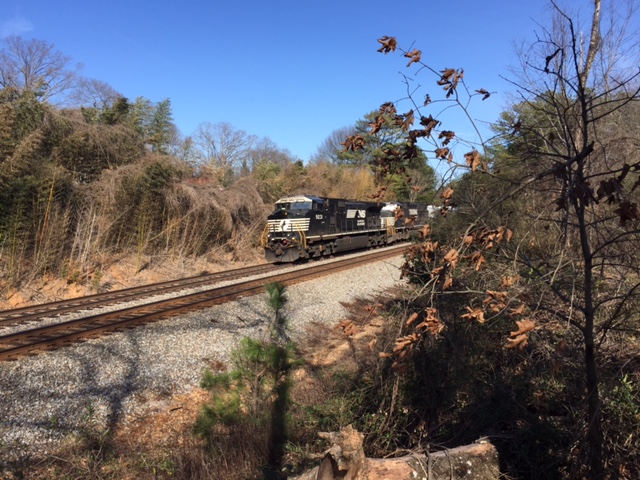As the primary narrow gauge line of the D&RGW, the line saw impressive narrow gauge traffic into the 1940s, but after WWII that traffic began to drop dramatically. The largest D&RGW narrow gauge engines, the K-36s and K-37s plied the line.
K-36 DRGW#489
K-37 DRGW#494
The line was severe, with 4% grades, and multiple turnback curves. Much of the line over Marshall Pass is still there, and can be driven in the summer months.
The main continues up the pass, winding through Shirley and Gray's, ultimately cresting the pass and encountering a major snowshed to protect the crossing. The snowshed covered the station, a passing track and even a turntable.
Marshall Pass Snowshed.
Western Side of Marshall Pass.
The western descent is also significant. The line descends through multiple curves through Shawano, at times allowing the train to pass through the same scene at least 4 times! This stretch o the line is remote, We work through Chester and Buxton and Sargent. From there, the line opens up, and runs across the valley to Gunnison. Gunnison was a division point, and the connection to additional branch lines. The main continued west out of Gunnison, and plunged into the Black Canyon of the Gunnison. This canyon was followed through the canyon until Crystal Creek enters the canyon. At this point, the canyon became so rugged that the line had to climb out of the confines of the canyon, and crest a ridge known as Cerro Summit, near the town of Cimarron. This pass was unspectacular, especially against such passes as Cumbres, Tennessee, Palmer, and Marshall.
Much of this route between Gunnison and Montrose now lies underwater. But along te route lies places such as Sapinero, and Curecanti, places that inspired the original D&RGW logos and advertizing. Now, Blue Mesa reservoir hides much of this region.
The railroad grade is somewhere below the surface.
I have built numerous Nn3 modules using Z-scale track, mechanisms and trucks, to represent N-scale Narrow Gauge. Modeling this line would be a significant shift of focus from the D&RGW standard Gauge to its narrow gauge operations.
Salida - if modeled as more than staging would still allow for the standard gauge to make an appearance. But the yard in Salida would be dual gauge, possible, but much more complex to model. However, operations including the Monarch Branch would be fascinating. The modeling of the route over the pass would be feasible, and Gunnison, as a Narrow Gauge division point supported several branch line operations. A little modelers license would allow for sufficient traffic on the line to be interesting. In particular, helper operations on both the East and West side of Marshall Pass.
A chief question becomes how far west to model. Gunnison makes a lot of sense as the end of the line, but modeling the Black Canyon is more than a little tempting. Recapturing something long gone has its appeal. However, one of the challenges, is that there is a lot less published material on this line than on lines that existed into the modern era. Not living in the region anymore, makes it a bit more difficult to reconstruct the line in sufficient detail to produce a solid model. These are all challenges, plus the fact that while we are seeing some solid steam engines in Z that could be rebuilt into Nn3 K-class locomotives, that would be a fair bit of work to build a prototype roster. It certainly is tempting to instead look at building this route, had it made it into a diesel era due to some source of new traffic discovered after WWII.
So, what would the operational LDEs be:
- Salida;
- Poncha Junction;
- Monarch Branch;
- Mears Junction (connection to San Luis Valley Line);
- Shirley and Gray's both had sidings and Water tanks;
- Marshall Pass;
- Shawano;
- Sargent;
- Parlin (Pitkin Branch Connection); and
- Gunnison (Crested Butte Branch, Balwin Branch, Kuebler Branch).
If extended to Montrose:
- Sapinero;
- Lake Junction (and the Lake City Branch);
- Cimarron;
- Cerro Summit;
- Cedar Creek; and
- Montrose.
The Scenic LDEs would be:
- Marshall Pass Snowsheds;
- Hilden (Snowsheds and Siding);
- Shawano Curves;
- Some of the other siding locations (i.e. Otto, Keene*, Pocono*, Chester, Tank 7, Buxton, Elko, Crookton, Doyle, Bonita, and Steele) Note: * - Single Ended Sidings;
- Black Canyon;
- Curecanti Needle;
- Crystal Creek Climb to Cerro Summit; and
- the Crystal Creek Bridge.
I know a lot less about this line than I really should. But that too is part of the fun. Considering this route in some fashion is a chance to learn more about the line and perhaps decide that it should b the focus.

















































.jpg)